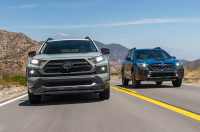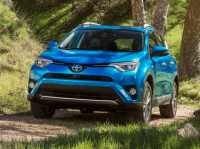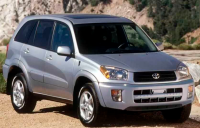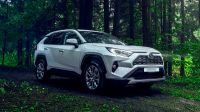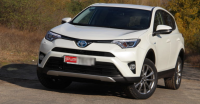Auto Camping Kings. Comparison of 2022 Subaru Outback Wilderness and 2021 Toyota RAV4 TRD Off-Road
Both cars are very similar to each other, despite the fact that Subaru has a larger size and a more powerful turbocharged engine, unlike the atmospheric engine in the Toyota RAV4. The Outback Wilderness is the first car in the new Wilderness lineup, which will include several more modifications. Outback Wilderness is based on Outback Onyx XT. Differences are 20 mm more ground clearance, new six-spoke black disks, all-road tires Yokohama Geolander, underbody protection, the presence of a towbar, updated roof rails, additional plastic body trim and new colors. All this at a cost of only $1,850 more than the Onyx XT. One set of rims and all-terrain tires will cost about $1,500, so you could consider this a very good deal. A rough estimate puts the cost of all the extras on the Outback Wilderness at about $3,000 and that's not including installation costs.
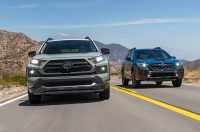 About the same applies to the Toyota RAV4 TRD Off-Road, which is based on the RAV4 Adventure. For the $2,625 price difference, we get new rims, Falken Wildpeak all-terrain tires, and a specially tuned suspension. It doesn't sound as attractive as the Outback Wilderness, but it's still not a bad deal.
About the same applies to the Toyota RAV4 TRD Off-Road, which is based on the RAV4 Adventure. For the $2,625 price difference, we get new rims, Falken Wildpeak all-terrain tires, and a specially tuned suspension. It doesn't sound as attractive as the Outback Wilderness, but it's still not a bad deal.
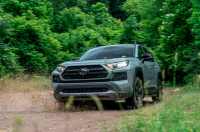 Both cars are designed for fans of outdoor activities, those who like to hike with tents, rafting on the river on kayaks, cycling and more. It is not necessary to perceive RAV4 and Outback Wilderness as serious off-roaders-vehicles. Taking into account the fact, that these cars with the big share of probability will be basic and unique for their owners, Toyota and Subaru tried very much that the brought changes have not affected negatively the behavior of cars on road. The result was not the most impressive, both models have their shortcomings, but Subaru is much better in the city and on the road compared to the more compact RAV4. Outback Wilderness has excellent driving qualities, despite the more tangible in comparison with other Outback body roll. In terms of comfort and smoothness, the Outback Wilderness is close to a premium car.
Both cars are designed for fans of outdoor activities, those who like to hike with tents, rafting on the river on kayaks, cycling and more. It is not necessary to perceive RAV4 and Outback Wilderness as serious off-roaders-vehicles. Taking into account the fact, that these cars with the big share of probability will be basic and unique for their owners, Toyota and Subaru tried very much that the brought changes have not affected negatively the behavior of cars on road. The result was not the most impressive, both models have their shortcomings, but Subaru is much better in the city and on the road compared to the more compact RAV4. Outback Wilderness has excellent driving qualities, despite the more tangible in comparison with other Outback body roll. In terms of comfort and smoothness, the Outback Wilderness is close to a premium car.
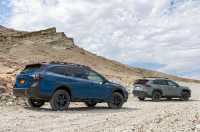 With the exception of a slightly empty steering wheel, sitting behind the wheel of the Wilderness is just as pleasant as driving the Outback Onyx XT. The spacious interior and soft and comfortable seats are enough to distract you from not the best noise isolation and some problems with the variator gearbox. In terms of drivability, the car performed even better than expected.
With the exception of a slightly empty steering wheel, sitting behind the wheel of the Wilderness is just as pleasant as driving the Outback Onyx XT. The spacious interior and soft and comfortable seats are enough to distract you from not the best noise isolation and some problems with the variator gearbox. In terms of drivability, the car performed even better than expected.
 Under the hood of the Subaru Outback Wilderness is a 260-horsepower turbocharged FA24F engine with 375 N∙m of torque and the aforementioned variator gearbox. Wilderness is not as fast as the WRX, but its power is enough to accelerate to a hundred in 6.1 seconds and drive 402 meters in 14.7 seconds. The presence of the variator did not hurt the car on the asphalt in any way. The variator in the Outback Wilderness provides smooth acceleration and responds quickly to the accelerator pedal. On the roads there are no questions to its work, perhaps, it is one of the best variator gearboxes.
Under the hood of the Subaru Outback Wilderness is a 260-horsepower turbocharged FA24F engine with 375 N∙m of torque and the aforementioned variator gearbox. Wilderness is not as fast as the WRX, but its power is enough to accelerate to a hundred in 6.1 seconds and drive 402 meters in 14.7 seconds. The presence of the variator did not hurt the car on the asphalt in any way. The variator in the Outback Wilderness provides smooth acceleration and responds quickly to the accelerator pedal. On the roads there are no questions to its work, perhaps, it is one of the best variator gearboxes.
 The same cannot be said of the RAV4 TRD Off-Road. Toyota's 2.5-liter four-cylinder atmospheric engine cannot be called powerful and smooth. The engine isn't strong enough for a vehicle of this weight, and its transmission is tuned for fuel economy, so you shouldn't expect to accelerate quickly, especially if you're going uphill. The car is not bad for normal everyday driving, just quick starts and simple overtaking is not about it.
The same cannot be said of the RAV4 TRD Off-Road. Toyota's 2.5-liter four-cylinder atmospheric engine cannot be called powerful and smooth. The engine isn't strong enough for a vehicle of this weight, and its transmission is tuned for fuel economy, so you shouldn't expect to accelerate quickly, especially if you're going uphill. The car is not bad for normal everyday driving, just quick starts and simple overtaking is not about it.
 Maximum engine power 203 hp revealed only at 6600 rpm, and maximum torque (249 N∙m) at 5000 rpm, which means that you often have to squeeze the gas pedal to the limit. The best acceleration time to a hundred, which managed to squeeze out of the RAV4 TRD Off-Road, was 8.5 seconds. To overcome 402 meters the car took 16.5 seconds, and its top speed was 139 km/h. Not bad figures for 2010, but for today's roads it is not enough.
Maximum engine power 203 hp revealed only at 6600 rpm, and maximum torque (249 N∙m) at 5000 rpm, which means that you often have to squeeze the gas pedal to the limit. The best acceleration time to a hundred, which managed to squeeze out of the RAV4 TRD Off-Road, was 8.5 seconds. To overcome 402 meters the car took 16.5 seconds, and its top speed was 139 km/h. Not bad figures for 2010, but for today's roads it is not enough.
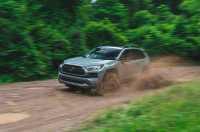 The RAV4 TRD Off-Road is based on the modular Toyota New Global Architecture, which keeps the RAV4 a compact crossover with excellent handling, which is almost unmatched in this segment. Even all-road tires have not made steerability worse. But there is one tangible disadvantage of the car. Shock absorbers of RAV4 TRD Off-Road are very rigid, and because of that the body always bounces even on relatively level road. As if Toyota tried to make the automobile more similar to a serious off-roader on purpose and they really managed to copy the worst characteristic of Jeep Wrangler. The crossover is inferior to the Outback Wilderness in terms of driving characteristics.
The RAV4 TRD Off-Road is based on the modular Toyota New Global Architecture, which keeps the RAV4 a compact crossover with excellent handling, which is almost unmatched in this segment. Even all-road tires have not made steerability worse. But there is one tangible disadvantage of the car. Shock absorbers of RAV4 TRD Off-Road are very rigid, and because of that the body always bounces even on relatively level road. As if Toyota tried to make the automobile more similar to a serious off-roader on purpose and they really managed to copy the worst characteristic of Jeep Wrangler. The crossover is inferior to the Outback Wilderness in terms of driving characteristics.
Still, the weak engine and stiff suspension aside, the RAV4 TRD Off-Road is the Corolla among crossovers. It is an affordable, reliable, easy to maintain and beautiful car, as evidenced by the fact that the RAV4 became the best-selling non-truck 2020 vehicle in the United States (more than 430,000 sold).
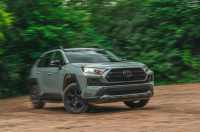 On the off-road both crossovers encountered some problems. RAV4 TRD Off-Road and Outback Wilderness easily overcame the winding dirt road studded with rocks and got to the uneven slope, offering many ways to go up and down. The RAV4 TRD Off-Road was the first to take the easiest route, but even this simple test was accompanied by creaking and clinging of the bottom to the ledges on the slope. TRD Off-Road ground clearance is only 5mm higher than the regular RAV4, which makes you question the logic of having the TRD logo on this crossover. Surprisingly, the nose of the car did not cause much trouble and did not cling to anything, but because of the small angle of the TRD Off-Road constantly sat on the bottom, protective plates which were very helpful.
On the off-road both crossovers encountered some problems. RAV4 TRD Off-Road and Outback Wilderness easily overcame the winding dirt road studded with rocks and got to the uneven slope, offering many ways to go up and down. The RAV4 TRD Off-Road was the first to take the easiest route, but even this simple test was accompanied by creaking and clinging of the bottom to the ledges on the slope. TRD Off-Road ground clearance is only 5mm higher than the regular RAV4, which makes you question the logic of having the TRD logo on this crossover. Surprisingly, the nose of the car did not cause much trouble and did not cling to anything, but because of the small angle of the TRD Off-Road constantly sat on the bottom, protective plates which were very helpful.
Another problem was the power, or rather lack of it. Climbing a steeper hill required almost full throttle pedal, and starting uphill on a slope after a full stop was difficult enough. Regardless of the chosen driving mode, the RAV4 TRD Off-Road struggled to cope with wheel spin, and when it finally began to move up the hill, just after a couple of meters from under the car was heard a terrible screeching.
After a few tests, my confidence in Toyota finally ran out. Is this a real TRD? This car had more weaknesses than advantages.
With Subaru Outback Wilderness things were better, but not by much. The 241mm of ground clearance of the car was enough not to cling to the ledges with the bottom, but Subaru had another problem. Where the Toyota clung to the ledges with its bottom, the Subaru buried its nose in the ground and rattled the bumper.
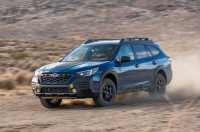 The Subaru's uphill climb was easier, but the difference was not enormous. Subaru's proprietary all-wheel drive system demonstrated excellent performance on low-grip surfaces. Every step on the gas pedal was carefully weighed by the car's electronics and power was very skillfully distributed to the wheels with the best grip. A little power to the front left wheel, now to the right - slippage! Back to the left again, maybe the back right? It worked! A little more, a little more, even more - and here the car is already at the top of the slope.
The Subaru's uphill climb was easier, but the difference was not enormous. Subaru's proprietary all-wheel drive system demonstrated excellent performance on low-grip surfaces. Every step on the gas pedal was carefully weighed by the car's electronics and power was very skillfully distributed to the wheels with the best grip. A little power to the front left wheel, now to the right - slippage! Back to the left again, maybe the back right? It worked! A little more, a little more, even more - and here the car is already at the top of the slope.
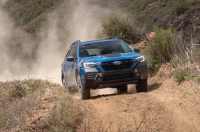 The variator gearbox, which performed well on smooth asphalt, showed its weaknesses in this test. The variator does not have time to react to the rapid reduction in torque when starting to drive on surfaces with low grip. Switching driving modes does not remedy the situation in any way.
The variator gearbox, which performed well on smooth asphalt, showed its weaknesses in this test. The variator does not have time to react to the rapid reduction in torque when starting to drive on surfaces with low grip. Switching driving modes does not remedy the situation in any way.
Are the Subaru Outback Wilderness and Toyota RAV4 TRD Off-Road ready for a trip through the desert and mountainous Namibia? Not likely. To get to a river, a remote village or a clearing in the woods? Sure. Are you into the outdoors? Take a closer look at the Outback Wilderness, if you do get stuck somewhere with this car, at least you'll be comfortable in it.
Second place: Toyota RAV4 TRD Off-Road (2021)
Low ground clearance, stiff suspension, and a weak engine make you question whether the car deserves the TRD logo.
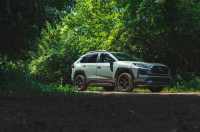 Pros:
Pros:
* Attractive and aggressive appearance
* Great handling for its segment
* Good equipment
Cons:
* Stiff suspension
* Weak engine
* Few differences from the usual RAV4
First place: Subaru Outback Wilderness (2022)
Powerful engine, attractive price, smoothness and comfort are slightly spoiled by not the most attractive appearance and mediocre off-road characteristics.
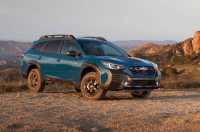 Pros:
Pros:
* Excellent value for money
* Powerful enough engine
* Smooth and comfortable ride
Cons:
* Strange appearance.
* Vario issues off-road
* Slightly empty steering wheel
